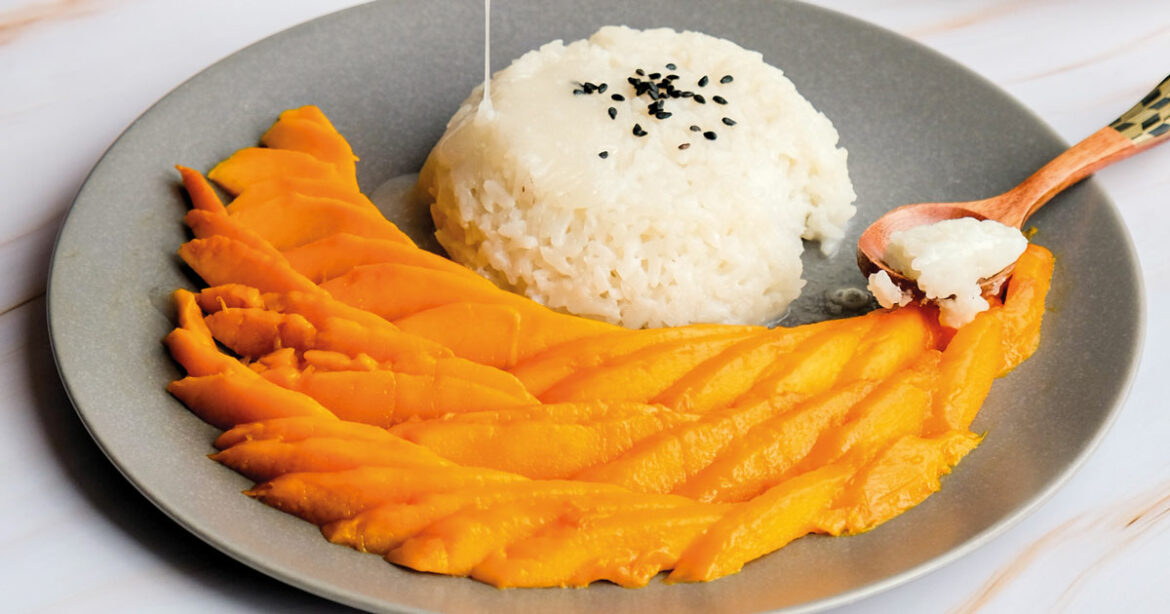Sunshine in fruit form, mangoes have a notoriously short season. Elisha Young (aka @elisha.eats on Instagram) shares how to make the most of this window of opportunity
I find it difficult to express just how much I adore mangoes. To give you an idea, during mango season I frequented my greengrocer so often she started referring to me as ‘the lady who really likes mangoes’. She also brought me one back from her holiday to the Dominican Republic. During lockdown, while others were stockpiling pasta, toilet paper and bread flour, I was instead planning how to get my fruit fix (I ended up getting crates of them delivered to my house, thanks to the modern miracle of online shopping).
People who are ambivalent towards mangoes are baffling – but I will concede that the fruit found in supermarkets is often not particularly enticing. Mainly kent or keitt varieties, they’re shipped in while still green and rock solid, meaning a lengthy ripening wait in the fruit bowl. There’s a high likelihood that the mango will spontaneously decide it doesn’t want to exist any more and develop unpleasant areas of black rot, or end up full of stringy fibres with a lacklustre, watery taste.
However, Indian and Pakistani mango season is a totally different ball game. The fruit is smaller, with a thin, delicate skin in bright yellow hues. The flesh is soft and juicy, intensely sweet, with a complexity that’s surprising and delicious – bright, floral and almost perfume-like.
For a mango newbie, the alphonso sorbet from Jack’s Gelato is a great starting point, and sometimes also includes add-ins like coconut, cardamom, chilli and sea salt. For fresh produce, one of the most reliable places is Al-Amin on Mill Road, where you can find cardboard boxes piled high. Mary’s Greengrocers in Sawston also has extremely reasonable prices and a great selection, with mango crates kept in a cooler at the back of the shop – so if you can’t see any, just ask!
When choosing mangoes, look out for unblemished skin that’s mostly green, with a flush of yellow-orange around the edges. While the alphonso variety is the most sought-after, it has a very short and early season. Kesar, chaunsa and sindhri varieties (sometimes called ‘honey’ mangoes) are all completely mouth-watering. As they ripen, they’ll become more and more golden – until they’re almost glowing.
Personally, I enjoy eating them by themselves as soon as they’re ripe, scooping out the flesh with a spoon – but I admit that the recipe ‘apply mango to face’ isn’t particularly inspiring, so I’ll also share how to make the incredible Thai dessert that is mango sticky rice.
Steam 150g glutinous rice for about 35 minutes, until the grains are soft. Meanwhile, heat 115g canned coconut milk in a saucepan with 30g sugar and 1/8 tsp fine sea salt. When the sugar is dissolved, stir through the steamed rice and let the liquid absorb. For the optional (but highly recommended) coconut caramel, heat 30g coconut milk with 20g sugar until thickened. Serve with one fresh mango, thinly sliced, and a mound of sticky rice drizzled with coconut caramel – garnished with toasted sesame seeds.
The salty-sweetness of the sticky coconut rice elevates the honeyed acidity of the mango, while the nutty sesame adds earthiness. It’s hard to believe that such simple ingredients could combine into something so lick-the-plate-clean good, but these mangoes really are that exquisite.
Just a warning: once you’ve tried a proper mango, you can never go back. And for that I make no apologies.

